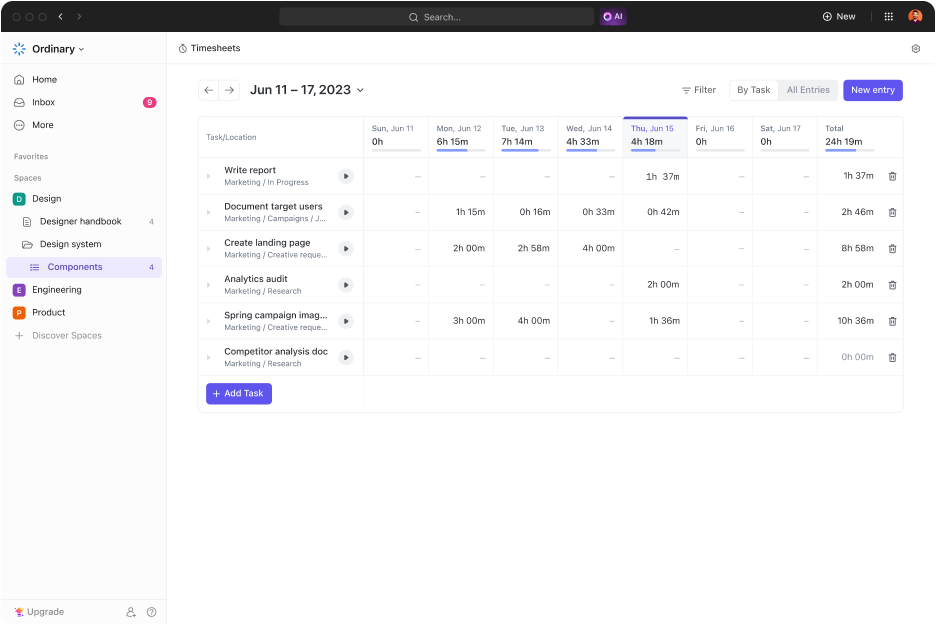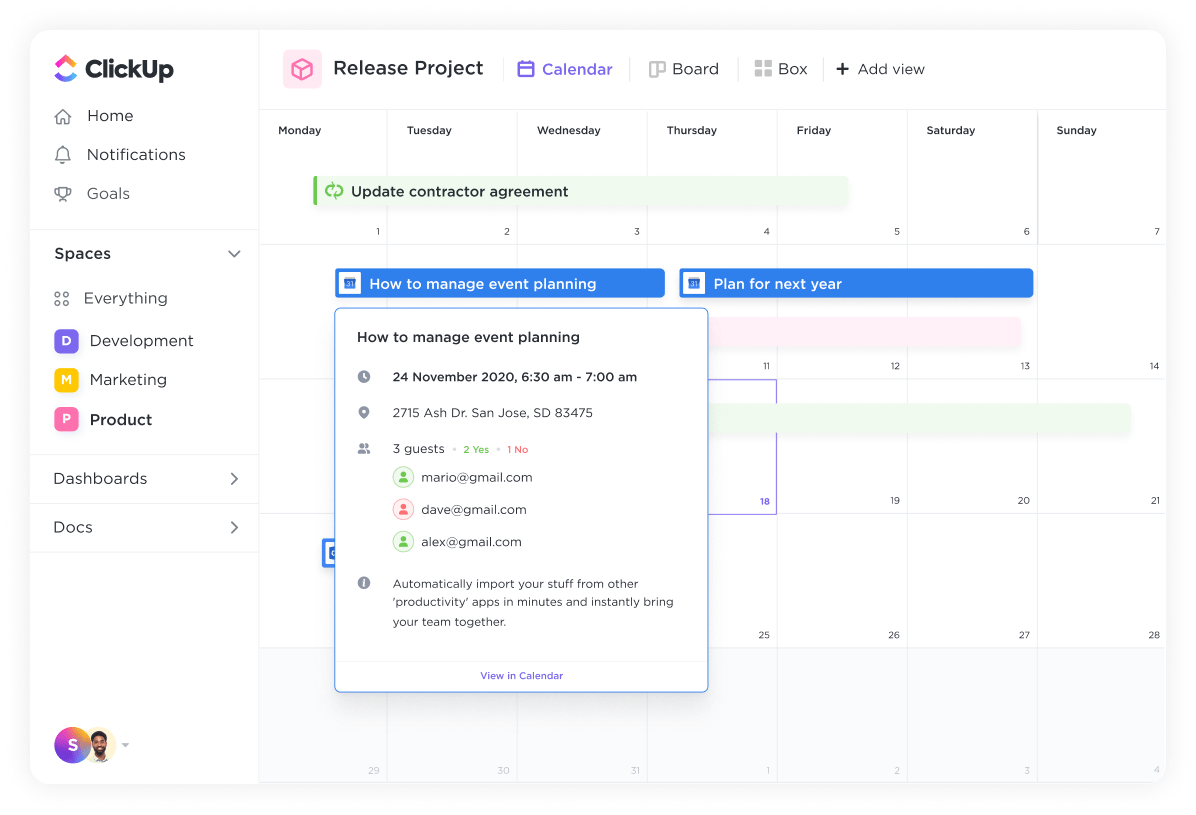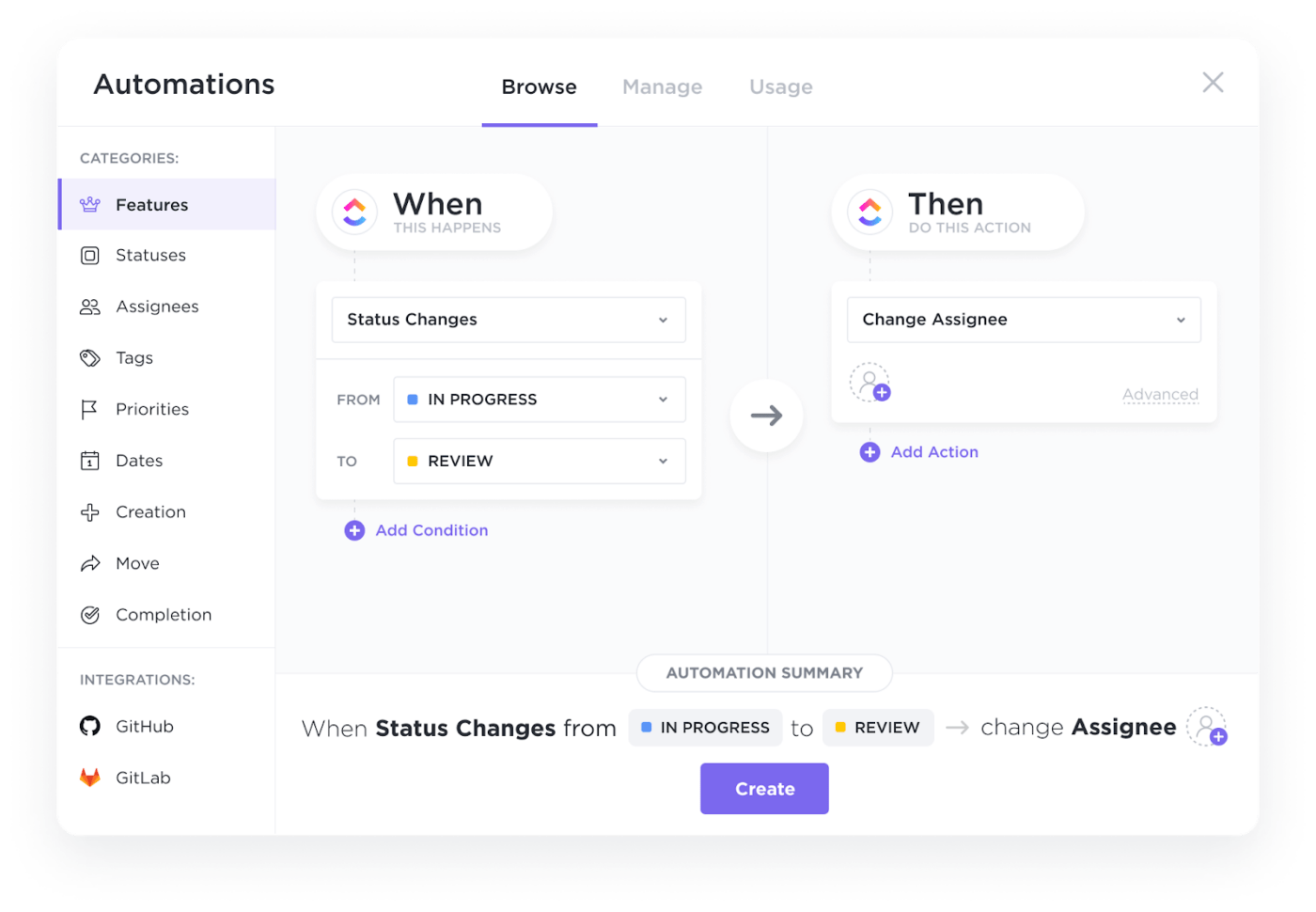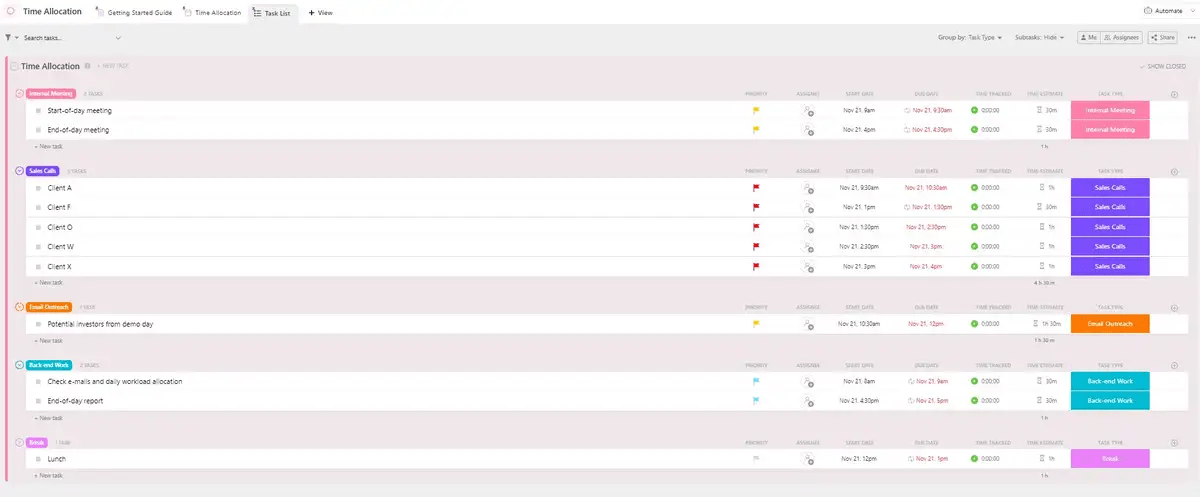وفقًا للأبحاث، فإن يقضي الموظف 2.6 ساعة يوميًا في إدارة رسائل البريد الإلكتروني وحدها، و40% من الموظفين لا يتتبعون هذا الوقت. يمكن أن يؤدي هذا السهو إلى خسارة فادحة للشركات التي تقوم بفوترة العملاء على أساس إدخال الوقت.
لذلك، يجدر بنا أن نتساءل - كم من إجمالي وقت العمل منتج؟ ما هو التوازن المثالي بين الساعات القابلة للفوترة وغير القابلة للفوترة؟ هذا هو المكان الذي يكون فيه تتبع الوقت مفيدًا.
يساعدك تطبيق أساسي لتتبع الوقت على فهم التكاليف الحقيقية لعمليات عملك ويوفر للمديرين التنفيذيين والمديرين والموظفين بيانات قيمة. من خلال تحليل هذه البيانات، يمكن للقادة الحصول على رؤى مهمة حول كيفية سير عملياتهم.
سواء كنت مدير مشروع أو صاحب عمل، فإن استخدام تطبيق تتبع الوقت أمر ضروري من أجل:
- البقاء منظماً وعلى رأس المشاريع
- اتخاذ القرارات المستندة إلى البيانات لتحسين الموارد
- تحسين أداء الموظفين
- تحديد التكاليف الخفية وتعظيم الأرباح
في هذا الدليل، سنستكشف في هذا الدليل فوائد متتبع الوقت وكيفية تطبيقه بفعالية وكيف يمكن أن يحول مؤسستك.
ما هو تقرير تتبع الوقت؟
يقيّم تقرير تتبع الوقت، أو الجدول الزمني، مقدار الوقت المستغرق في مختلف مكونات المشروع، خلال فترة زمنية محددة. ويمكنه أيضًا مقارنة الوقت الفعلي المستغرق بالتوقعات والتقديرات السابقة.
وبالتالي، فإن تقرير تتبع الوقت يمكّنك من اتخاذ قرارات مستندة إلى البيانات، وتحسين كيفية قضاء فريقك لوقته، وضمان بقاء المشاريع على المسار الصحيح. والغرض منه هو تحقيق أفضل استفادة من الوقت دون انقطاع مستمر لتحديثات التقدم.
يمكن لتقارير وقت المشروع أن تسد الفجوة بين التقدير المثالي للمشروع وتحديات التنفيذ في العالم الحقيقي. وهي ذات قيمة خاصة للتنبؤ بالموارد وإدارتها بفعالية وتحديد مواعيد نهائية واقعية.
كما أن تقارير تتبع الوقت لا غنى عنها لفواتير العميل. تضمن بيانات تتبع الوقت حساب كل ساعة عمل، الأمر الذي لا يمنع تسرب الإيرادات فحسب، بل يساعدك أيضًا على إصدار الفواتير للعملاء بدقة.
اقرأ أيضًا: أفضل 10 برامج لتتبع الوقت 2024
كيفية استخدام برنامج تتبع الوقت لتتبع الوقت بشكل فعال؟
غالبًا ما يبدو تتبع الوقت وكأنه عمل روتيني إضافي. قد يكره الموظفون العمل الإضافي المتمثل في ملء أداة تعقب الوقت يدويًا والإشراف الذي تنطوي عليه مراقبة أنشطتهم. ومع ذلك، يُتوقع من المديرين التأكد من دقة تقديم الطلبات في الوقت المناسب.
ومع ذلك، فإن تقارير تتبع الوقت ضرورية للعديد من الشركات. توفر بيانات الوقت الدقيقة رؤى قيمة، سواءً كانت فوترة العملاء بالساعة أو تحليل إنتاجية الفريق. المفتاح هو اختيار أساليب وأدوات فعالة تقلل من الجهد المبذول مع تقديم المعلومات الضرورية. ClickUp لإدارة الوقت مجموعة قوية من الميزات التي تجعل من تتبع الوقت جزءًا لا يتجزأ من عملية إدارة مشروعك.
دعنا نستكشف كيف يمكن أن تساعدك هذه الميزات على تحسين إدارة وقت المشروع .
💡 نصيحة احترافية: تأكد من الحصول على موافقة مسبقة من موظفيك بشأن تتبع الوقت. من المفيد إبلاغهم بأن هذا الأمر مخصص فقط لقياس الوقت المستغرق في المهام. سيساعد هذا في بناء الثقة بين موظفيك ولن يُنظر إليه على أنه ممارسة تطفلية.
تمكين تتبع الوقت وتسجيلات المهام في ClickUp
الخطوة الأولى هي تمكين متتبع الوقت داخل مساحة العمل الخاصة بك. بمجرد التفعيل، يمكن لفريقك البدء في تسجيل الساعات مباشرةً في ClickUp وتتبع الساعات دون تعطيل سير عملهم.
من السهل تتبع الوقت في ClickUp. عند بدء مهمة، ما عليك سوى النقر على المؤقت. سيقوم ClickUp بتسجيل وقتك. عند الانتهاء، أوقف المؤقت لتسجيل ساعاتك.
بالنسبة للمهام التي لا يناسبها المؤقت (مثل الاجتماعات أو البحث)، يمكنك تسجيل وقتك يدوياً. يضمن ذلك تسجيل كل دقيقة عمل لإعداد تقارير دقيقة.
الجداول الزمنية الآلية
![]()
إضافة الوقت بأثر رجعي أو إنشاء إدخالات حسب نطاق التاريخ مع تتبع الوقت يدويًا الجداول الزمنية الآلية يمكن أن تكون موفرة للوقت للفرق التي تتعامل مع حجم كبير من المهام أو لديها احتياجات معقدة لإعداد التقارير.

احصل على رؤى قابلة للتنفيذ لتحسين كفاءة فريقك باستخدام الجداول الزمنية لتتبع وقت المشروع من ClickUp
يقلل من الأخطاء وينشئ تقارير دقيقة وسهلة العرض. كما أنه يجمع سجلات الوقت في سجلات دقيقة لساعات العمل. وهذا يوفر الوقت لأعضاء الفريق والمديرين.
يمكن للفرق التركيز على عملهم، بينما يمكن للمديرين رؤية تقدم المشروع وعبء عمل الفريق في الوقت الفعلي.
اقرأ أيضًا: أفضل 10 برامج لتتبع الوقت المستقل في عام 2024
الاندماج مع تقويم جوجل
🧠 هل تعلم: تقريبا 21٪ من الموظفين لا يتتبعون وقتهم التي يقضونها في الاجتماعات، مما يكلف الشركات ما معدله 32,000 دولار سنويًا لكل موظف في المتوسط من الإيرادات المفقودة.
لجعل هذا الأمر سهلاً، يتكامل ClickUp بسلاسة مع تقويم Google لضمان انعكاس التحديثات التي يتم إجراؤها في أحد التطبيقين على الفور في التطبيق الآخر. وهذا يلغي الحاجة إلى التبديل ذهابًا وإيابًا.
تتبع وقت مشروع ClickUp تتبع وقت المشروع

حافظ على المزامنة مع تكامل تقويم Google من ClickUp وتتبع الوقت دون تبديل الأدوات
- إنشاء المهام من أحداث التقويم: باستخدامتتبُّع وقت المشروع في ClickUpيمكن للفرق إنشاء مهام ClickUp مباشرةً من أحداث تقويم Google. وهذا يعني أن كل موعد أو اجتماع يصبح مهمة قابلة للتتبع في ClickUp
- الاستفادة من الأتمتة في التذكيرات: قم بأتمتة التذكيرات للأحداث القادمة ولا تفوّت أي اجتماع أو موعد نهائي مهم. سيقوم ClickUp بإرسال إشعارات مباشرة إلى مساحة العمل الخاصة بك، مما يبقيك منظمًا وعلى رأس جدولك الزمني
- تحويل الأحداث إلى مهام قابلة للتنفيذ: عندما تقوم بجدولة اجتماع، سيقوم ClickUp تلقائيًا بإنشاء مهمة تحتوي على جميع التفاصيل ذات الصلة، مما يسمح لك بإضافة المزيد من المعلومات مثل جداول الأعمال والمكلفين وقوائم المراجعة والمزيد. هذا يجعل أحداثك ومهامك مركزية,مما يسهل تتبع الوقت دون التبديل بين الأدوات
إنشاء تقارير مخصصة
أحد أقوى جوانب ميزة تتبع الوقت في ClickUp هو قدرته على إنشاء تقارير مخصصة.
من خلال التقارير المخصصة، يمكنك عرض سجلات تتبع الوقت التراكمي لكل عضو من أعضاء الفريق لفهم الوقت الذي يقضيه في مجموعة مختارة من المهام.
تسمح لك ميزة ClickUp بتخصيص التقارير استنادًا إلى مقاييس مختلفة، مثل الوقت الذي تم تتبعه حسب اليوم أو الأسبوع أو الشهر أو أي نطاق مخصص، مثل إجمالي الوقت المستغرق في مشروع ما، أو الوقت المخصص لمهام محددة، أو إنتاجية أعضاء الفريق كل على حدة.
بالنسبة لمديري المشاريع، تساعد التقارير المخصصة على:
- تحديد المشاريع التي تحتاج إلى مزيد من الاهتمام، وتقييم عبء عمل الفريق، وتعديل تخطيط الموارد حسب الحاجة
- اكتشاف فرص زيادة الكفاءة والتنبؤ بالجداول الزمنية للمشروع بشكل أفضل
- تجنّب انتكاسات المشروع مثل تخصيص الموارد بشكل عام، والاختناقات، وإرهاق الفريق، وفقدان المواعيد النهائية
يؤدي هذا التحسين المستمر إلى تخطيط دقيق، وتخصيص أفضل للموارد، وفي نهاية المطاف، مشاريع ناجحة.
اقرأ أيضًا: أفضل أدوات تتبع وقت الوكالات للمبدعين والمسوقين في عام 2024
الاستفادة من القوالب لتتبع الوقت بكفاءة
تقدم ClickUp مكتبة من القوالب المصممة لتبسيط عمليات تتبع الوقت. يمكن تخصيص هذه القوالب لتلائم الاحتياجات المحددة لمشاريعك، مما يضمن الاتساق في تسجيل الوقت وإعداد التقارير عبر الفرق.
قالب تعقب وقت المستشارين ClickUp Time Tracker
تم تصميم قالب تتبع وقت المستشارين من ClickUp لمساعدتك في تتبع ساعات عمل المستشارين المدفوعة والمدفوعات.
قالب تعقب وقت المستشارين في ClickUp مصمم خصيصًا لمساعدة الاستشاريين على إدارة وقتهم بكفاءة مقابل مشاريع العملاء المختلفة.
تتكامل أداة تعقب الوقت بسلاسة مع ميزات إدارة المشاريع في ClickUp، مما يوفر منصة شاملة لتتبع الساعات المدفوعة وزيادة الإنتاجية وتحسين العلاقات مع العملاء.
كما أنه يبسِّط عملية تتبع الوقت للاستشاريين، مما يسمح لهم بتسجيل الساعات يدوياً أو باستخدام أجهزة ضبط الوقت بسهولة. وهذا أمر قيِّم للاستشاريين الذين يديرون مشاريع متعددة، مما يضمن تسجيل جميع أعمال العميل بدقة.
يؤدي ذلك إلى تصنيف واضح لساعات عملهم على أنها قابلة للفوترة أو غير قابلة للفوترة، مما يسهل عملية إعداد الفواتير الدقيقة والمساءلة المالية.
قالب تخصيص وقت النقر
تم تصميم قالب تخصيص الوقت من ClickUp لمساعدتك على إدارة وقتك ومواردك بشكل أفضل.
قالب تخصيص الوقت في ClickUp هو أيضًا أداة ممتازة لمديري المشاريع الذين يحتاجون إلى تتبع الوقت عبر مهام متعددة وأعضاء الفريق. يتيح لك هذا القالب تحديد فئات محددة مسبقًا لأنواع مختلفة من العمل، مثل التطوير والتصميم والاجتماعات.
💡 نصيحة احترافية: للوكالات التي تدير عدة عملاء, تنفيذ قوالب الجداول الزمنية للوكالات يمكن أن يكون مفيدًا. تعمل هذه القوالب على توحيد تتبع الوقت عبر مختلف العملاء والمشاريع، مما يسهل ضمان تسجيل جميع الساعات المدفوعة والإبلاغ عنها بدقة.
أتمتة تتبع الوقت أتمتة ClickUp تخفف العبء عن فريقك لتتبع ساعات العمل. يمكنك تكوين الأتمتة لبدء تتبع الوقت تلقائيًا عندما تتغير حالة المهمة إلى "قيد التقدم" وإيقافها عندما يتم وضع علامة "مكتمل" على المهمة.
يتم تحديث هذه الميزة تلقائيًا عندما تتغير الفرق والمسؤوليات وتحافظ على سير المشاريع مع تحرير فريقك من مشاركة تحديثات المشروع المنتظمة.

تعمل أتمتة ClickUp على تبسيط إدارة المهام عن طريق تعيين المهام تلقائيًا عند تغير الحالة
تضمن الأتمتة تتبع الوقت بشكل متسق، مما يقلل من الأخطاء البشرية، ويضمن تسجيل البيانات بدقة.
اقرأ أيضًا: كيفية استخدام الذكاء الاصطناعي لإدارة الوقت (حالات الاستخدام والأدوات)
## لماذا تتبع الوقت وإعداد التقارير مهم
توفر تقارير تتبع الوقت البيانات اللازمة لتحسين الموارد وضمان إنجاز المشاريع في الوقت المحدد وفي حدود الميزانية. كما أنها تساعد في تحسين إنتاجية الفريق والمساءلة وتجنب تسرب الإيرادات.
دعنا نستكشفها أكثر.
⏰ ⏰ فهم الطلب على الموارد
ساعات عمل الموظفين هي مؤشر حيوي لتخصيص الموارد. يمكن أن يساعد استخدام تطبيق تتبع الوقت الحر في تحديد المهام التي تتجاوز باستمرار تقديرات الميزانية، مما يسمح بالتدخل المبكر.
بالإضافة إلى ذلك، يمكن أن يكشف عن الثغرات في مهارات الموظفين، مما يسلط الضوء على الحاجة إلى المزيد من التدريب. كما أنه يساعد في تحديد المهام التي تعاني من نقص الموارد. يمكن أن يشير تحديد التباينات في عبء العمل إلى الحاجة إلى إجراء تعديلات، مثل إعادة توزيع المسؤوليات أو تقاسم المهام بشكل أكثر إنصافًا.
من خلال معالجة هذه القضايا، يمكنك إنشاء عروض أسعار أكثر دقة، مما يؤدي إلى معدلات فوترة أعلى على المدى الطويل
### ⏰ تحسين طريقة عمل الفرق
الموظفون منتجون فقط من أجل 2 ساعة و53 دقيقة في اليوم
يمكن أن يزيد تطبيق تتبع الوقت من التركيز حيث يصبح الموظفون أكثر وعياً بالساعات التي يقضونها في المهام. من خلال مراجعة وقتهم، يمكن للموظفين تحديد الأنماط وتقليل العمل غير القابل للفوترة.
لا يتعلق تتبع الوقت بتحديد توقعات غير واقعية؛ بل يتعلق بالوعي الذاتي والقرارات المستندة إلى البيانات. مع وجود برنامج تتبع الوقت المناسب، غالبًا ما تدرك الفرق في كثير من الأحيان أنها تقوم بتبديل المهام بشكل متكرر جدًا أو لا تخصص وقتًا كافيًا للتركيز على مهمة واحدة.
ومن خلال تحديد أوجه عدم الكفاءة، مثل الاجتماعات غير الضرورية أو اختناقات العمليات التي تهدر ساعات العمل المدفوعة الأجر، يمكن للفرق إجراء تعديلات صغيرة على سير العمل لتحسين الكفاءة الإجمالية بشكل كبير بمرور الوقت.
👀 المكافأة: تطبيق قوالب الجداول الزمنية للتأكد من أن جميع أعضاء الفريق يسجلون وقتهم بنفس الطريقة. هذا يجعل من السهل تحديد الاتجاهات واتخاذ القرارات المستندة إلى البيانات.
⏰ الحصول على رؤى حول أداء الفريق
تقدم تطبيقات تتبع الوقت معلومات مفصلة عن أداء الموظفين. يمكنك تحليل هذه البيانات لتحديد الموظفين الأكثر كفاءة وتقدير مساهماتهم. سيعزز هذا التقدير الروح المعنوية ويشجع على استمرار الأداء العالي.
بالإضافة إلى تحديد أفضل الموظفين، يمكن أن يكشف تتبع الوقت أيضًا عن نقاط القوة والضعف. يمكن أن تساعدك إدخالات الوقت المتتبعة والعادات والأنماط على تحديد المجالات التي قد يعاني فيها الموظفون.
تتيح لك هذه المعلومات تقديم الدعم المستهدف ومساعدتهم على تحسين كفاءتهم.
⏰ ⏰ إنشاء سجل للوقت المستغرق
لا يوفر تتبع الوقت بيانات موجزة فحسب، بل ينشئ أيضًا سجلاً مفصلاً لعمل فريقك.
على سبيل المثال، إذا تساءل العميل عن ساعات العمل التي قضاها في مشروع ما، يمكنك إنشاء تقرير يحدد بوضوح المهام المحددة المنجزة والوقت المستثمر. يمكن أن تساعد هذه البيانات في تبرير التكاليف ومعالجة التوقعات غير المعقولة. في صناعات مثل الإنشاءات، حيث تكون عمليات التدقيق شائعة، يعد تتبع الوقت أمرًا بالغ الأهمية لإثبات استخدام الموارد بفعالية.
يعد السجل الدقيق للعمل المنجز والوقت المستغرق أمرًا ضروريًا لإثبات الامتثال ومنع الاتهامات بإهدار الأموال.
⏰ تجنب تسرب الإيرادات وفوترة العملاء بدقة
تكشف بيانات تتبع الوقت عن المشكلات التي تستنزف الإيرادات مثل عدم كفاءة سير العمل، والإفراط في عدد الموظفين، ومراقبة التقدم المحرز بشكل غير منتظم، وغير ذلك.
غالبًا ما تكون هذه المشاكل مترابطة. يمكن أن يؤدي سير العمل غير الفعال إلى زيادة عدد الموظفين، مما يؤدي بدوره إلى زيادة النفقات العامة، ويؤدي الرصد غير المتكرر إلى تأخير المشروع.
يمكن لبرنامج تتبع الوقت معالجة جميع هذه المشاكل:
- يحدد الاختناقات في سير العمل: يحدد الأماكن التي يضيع فيها الوقت
- تحسين التوظيف: يحدد ما إذا كان تخصيص الموارد يتماشى مع عبء العمل
- تحسين تحديثات التقدم المحرز في المشروع: يمكن للفرق التواصل بشكل أفضل مع قدرتها على الوفاء بالمواعيد النهائية
يساعد برنامج تتبع الوقت في إنشاء سجل تاريخي لبيانات المشروع. يمكنك معرفة المدة التي استغرقتها المشاريع وتكاليفها وربحيتها. يمكن أن تساعدك هذه المعلومات على تزويد العملاء بفواتير مفصلة وشفافة.
يمكنك استخدام ميزات إعداد تقارير ClickUp لمقارنة الوقت المستغرق في كل مهمة مع الميزانية المخصصة لها. وهذا يسمح لك بتحديد المجالات التي قد يكون لديك فيها إنفاق زائد واتخاذ إجراءات تصحيحية قبل أن يتجاوز المشروع الميزانية.
بالإضافة إلى ذلك, دمج برنامج تتبع PTO يضمن حساب الساعات القابلة للفوترة وغير القابلة للفوترة، مما يمنحك صورة أكثر دقة عن مدى توفر فريقك وعبء العمل.
اقرأ أيضًا: أفضل 10 تطبيقات للجداول الزمنية لإدارة الوقت بشكل أفضل في عام 2024
### ⏰ بناء الثقة من خلال الشفافية في عمليات الفريق
يمكن لبيانات تتبع الوقت أن تعزز الثقة والشفافية داخل مؤسستك، مما يعود بالنفع على كل من الموظفين والمديرين. توفير رؤية واضحة لساعات العمل يمكن أن يخفف أيضًا من المخاوف بشأن الإدارة التفصيلية
باستخدام برنامج تتبع الوقت المناسب، يظل المديرون على اطلاع دائم بأنشطة المشروع، مما يضمن إعطاء الأولوية للمهام الصحيحة.
ويشعر الموظفون بدورهم بالثقة والتمكين في أدوارهم، مما يقلل من الحاجة إلى المراجعات المتكررة. في نهاية المطاف، عندما يتتبع كل من المديرين وأعضاء الفريق الوقت، فإن ذلك يخلق تكافؤًا في الفرص ويعزز العلاقات.
تتبع ساعات العمل بسهولة باستخدام ClickUp
يمكن أن تؤدي الاستفادة من برنامج تتبع الوقت إلى إدارة ناجحة للمشروع. فهو يوفر الرؤى اللازمة لتحسين سير العمل وتحسين الإنتاجية وضمان إنجاز المشاريع في الوقت المحدد وفي حدود الميزانية.
صُممت ميزات ClickUp لتتبع الوقت بحيث تندمج بسلاسة في سير العمل الحالي، مما يوفر المرونة اللازمة لإدارة الوقت بشكل أكثر فعالية.
سواء كنت صاحب عمل أو تشرف على مشاريع معقدة، فإن ClickUp يوفر لك الأدوات التي تحتاجها لإبقاء كل شيء على المسار الصحيح. سجِّل ساعات العمل بدقة، وأنشئ تقارير مخصصة، واستفد من القوالب لضمان تسجيل ساعات العمل وعمل فريقك بأعلى كفاءة.
باستخدام ClickUp، يمكنك تحويل تتبع الوقت من مهمة عادية إلى أداة قوية لتحقيق نجاح المشروع. ابدأ مع ClickUp مجانًا اليوم!


